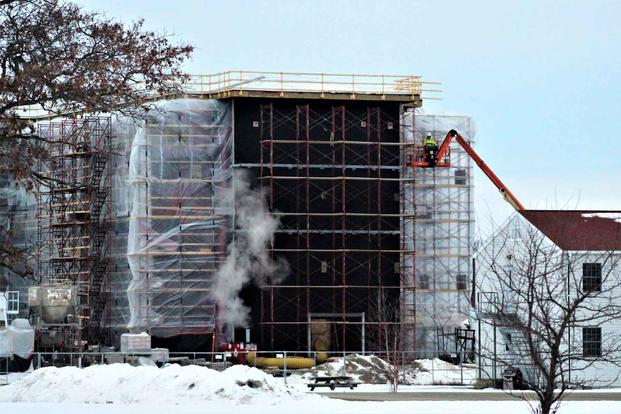The Army is eyeing a massive increase in its funding to maintain aging barracks and build new base housing for junior troops in one of its most dramatic single budget requests to Congress in recent years.
In its proposed budget, the Army is seeking a total of $2.35 billion for barracks in 2025, a major boost from this fiscal year's $1.5 billion budget request.
The Army’s proposed boost, which includes tripling its budget to construct new barracks, signals the service has taken enormous steps in elevating living conditions as a priority, siphoning funds from other parts of the service.
Read Next: Navy Shock Trauma Platoon in Norway NATO Exercise Puts Lessons of Ukraine War to Use
The service’s overall budget request is $185.9 billion -- a 0.2% increase from this year -- that when adjusted for inflation, has the Army potentially operating in 2025 with effectively the same budget. However, the final figures could change as Congress takes the request and starts working out its own version of the Army budget.
That potential boost would fulfill what service leaders have long called a top priority and will likely be among the heaviest lifts in the proposed budget for the Army, which needs Congress to back and approve the added money. It signals that Army planners are finally trying to wrap their arms around the growing quality-of-life issues and poor housing conditions faced by junior troops.
If successful, the major increase in funding for barracks improvements could also be among the most meaningful accomplishments in Army Secretary Christine Wormuth's tenure, who, in an October interview with Military.com, said that the service needs a "generational" investment in barracks.
“Despite an overall flat Army budget and many competing resource requirements, we are significantly increasing funding for barracks construction, restoration, and modernization,” Wormuth said in a statement to Military.com. “We will continue to work with Congress to make barracks a long-term investment priority, as the Army still faces a significant maintenance backlog in our large inventory of aging barracks.”
The ambitious request also puts the ball in Congress' court after lawmakers have started to signal that the service should make bigger cash requests to repair dilapidated barracks and replace its aging infrastructure, some of which is a half-century old.
A divided Congress has usually failed to pass a defense budget on time -- before the start of the fiscal year in October -- in recent years. Instead, it has usually relied on stopgap spending bills to avoid government shutdowns that buy Capitol Hill time to negotiate. That patchwork funding makes it difficult for the Army to plan major construction efforts, officials have warned.
Congress has yet to pass the Army’s fiscal 2024 funding, which has had a significant impact on the service’s barracks efforts for this year. At least five construction efforts worth $237 million have been stalled, one Army official told Military.com. Installations with stalled projects include Fort Liberty, North Carolina; Joint Base Lewis-McChord, Washington; and Natick Soldier Systems Center, Massachusetts.
The Army’s proposed 2025 budget also includes fully funding sustainment, at $680 million, which is part of the larger $2.35 billion proposed barracks budget. In past years, roughly 15% of the budget has been siphoned off to other priorities. That sustainment request, which effectively funds barracks maintenance, is also an increase from this year's $567 million.
The Army conducted a servicewide inspection of all its 6,700 barracks buildings last year following a series of reports from Military.com on poor living conditions.
It found 23% of them in "poor" or "failing" condition. About 5% of the housing in poor or failing condition was temporary barracks set up at locations such as schools or major training centers, which are lower in priority compared to soldiers' homes.
For decades, the Army has struggled with its aging infrastructure -- much of it consisting of barracks infected with mold and pests or otherwise unsafe or falling apart. The issue in some cases has gotten so bad that soldiers have reported being hospitalized or sick with symptoms consistent with long-term exposure to black mold.
Meanwhile, the service is considering privatizing its barracks, with a pilot plan in the early stages at Fort Irwin, California. Army planners aim to meet with key contractors throughout the spring to see what expanding privatization would look like. In some scenarios, that could mean contractors taking over existing barracks instead of outright building new ones.
But for now, the Army is eyeing a major list of new construction projects, all of which house between 100 and 220 soldiers. They include:
- A $117 million barracks project at Fort Johnson, Louisiana
- $180 million for Old Guard soldiers at Joint Base Myer-Henderson Hall, Virginia
- A $161 million project at Joint Base Lewis-McChord in Washington state
- A $39 million project at Fort Buchanan, Puerto Rico
- $42 million for new training barracks at Camp Parks, California
- $144 million for Advanced Individual Training, or AIT, barracks at Fort Leonard Wood, Missouri
- $191 million for two Army Garrison Ansbach barracks projects in Germany
- $61 million for Smith Barracks at Army Garrison Rheinland-Pfalz in Germany.
Related: Army's Idea to Privatize Barracks Has Some Cautious Bipartisan Support on Capitol Hill












